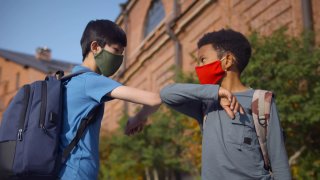

The following content is created in partnership with Stanford Children’s Health. It does not reflect the work or opinions of the NBC Bay Area editorial staff. Click here to learn more about Stanford Children’s Health.
Many schools are preparing to return to in-person learning—something many students haven’t done in over a year. And as children count down the days to a new school year, they might be experiencing a range of emotions: Yes, it’s exciting to think about seeing friends and teachers, but it can also be nerve-racking to think about what a typical school day will look like now.
These kinds of anxious feelings are perfectly normal. Just the same, though, experts feel confident that it’s safe for kids to go back. "We have good evidence showing that we can safely have kids in school with appropriate measures and precautions, even if they're not vaccinated,” says Dr. Julia Pederson, a pediatrician at the Pediatric Group of Monterey with Stanford Children's Health.
Get a weekly recap of the latest San Francisco Bay Area housing news. Sign up for NBC Bay Area’s Housing Deconstructed newsletter.
Having a plan for your child is key to a smooth transition back to school. Here are a few ways to help your child start the school year on the right foot.
Create a routine
Routines play a major part in our everyday lives, helping us organize our daily tasks. Research shows that routines make children feel secure, helping them better understand everyday events. Doing a walkthrough of what a day at school will look like can help set expectations for your child.
Wearing masks throughout the school day is one routine children may need getting used to—one of many safety protocols schools may put in place to keep students safe. To help your children adapt, practice what it may look like to walk into the classroom, sit down, and keep a mask on. Some children may not be comfortable wearing a mask for long periods, but practicing at home a few hours daily can help ready them for the first day of school.
Other routines that may require some practice: regular handwashing and properly covering a sneeze or cough. While some students may not be used to such protocols, it’s important to get them ready.
Preparing routines will let your child know what to expect when they’re at school and recognize when something doesn’t seem right. Like any routine, these safety measures will takes time to get used to. But slowly, it will become an easy process.
Set time aside
For many, the pandemic helped create family time: Remote learning and working have given parents and children more time to spend together. Returning to school doesn’t have to change this.
Continue to set time for the activities you’ve enjoyed during the quarantine. Whether it’s going on walks, having meals together, or just watching a movie, make the time for it. This can also give you and your child something to look forward to after a day at school.
Talk it out
Expressing how you feel doesn’t come easy to everyone. Sometimes your child might not say how they’re feeling about returning to school—and that’s okay. Answering questions and having an open dialogue can help your child ease into communicating their feelings and concerns.
These conversations can also carry on during the school year. Asking how their day went and giving them a safe space to talk can help you gauge how their transition is going. You should also keep an eye out for certain other signs like lower grades, whether they seem to be avoiding school, and even if they’re having trouble sleeping or eating. Staying in close contact with your child’s teacher can also help you track their progress, both academic and personal.
Helping your child navigate this new journey is not a one-size-fits-all approach. Reaching out to a pediatrician at Stanford Children’s Health can help you figure out how to best handle the new school year. Click here to learn more about Stanford Children’s Health.

